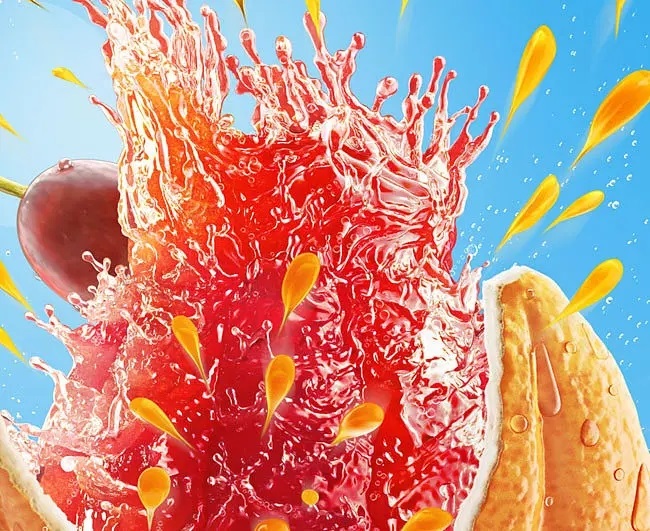However, fruit juice (original fruit juice) drinks, fruit juice drinks or fruit juice drinks with pulp, etc., the basic principle and process of production are roughly the same. The production line of fruit juice drinks mainly includes: pretreatment of fruit raw materials, juicing or extraction, clarification and filtration, homogenization, deoxidation, concentration, composition adjustment, packaging and sterilization, etc. (cloudy juice does not need clarification and filtration).

(1) Selection and washing of raw materials
1. It should have good flavor and aroma, stable color, moderate acidity, and still maintain these excellent qualities during processing and storage, without obvious adverse changes.
2. Rich juice, easy to extract juice, high juice rate.
3. Fresh raw materials, no rotten fruit. When using dried fruit raw materials, dried fruit should be free from moldy or moth-eaten fruit.
(2) Juice extraction and extraction
(1) Crushing and beating
Purpose of crushing: to increase the rate of juice extraction
(2) Pretreatment before juicing
a. Heating
The production line of fruit juice beverage is suitable for red grape, red western cherry, plum, hawthorn and other fruits.
Principle: Heating makes the protein in the cell protoplasm coagulate, changes the cell's semi-permeability, at the same time makes the pulp soften, the pectin hydrolyzes, reduces the viscosity of the juice, thus improving the juice yield.
b. Add pectinase
(3) Juice
Juicing methods vary depending on the structure of the fruit, where the juice is present, organizational properties and the quality requirements of the finished product.
a. Most fruit juice is contained in the whole fruit -- crushed and pressed.
b. Have thick rind (citrus, pomegranate, etc.) - juice one by one or peel first.
Fruit juice yield depends on fruit texture, variety, ripeness and freshness, processing season, juicing method and juicing efficiency.
(4) coarse filter
(3) Clarification and filtration of juice
(1) Clarification
Charge neutralization, dehydration and heating are sufficient to cause aggregation and precipitation of colloidal particles. One colloidal can activate another colloidal and make it easy to precipitate by electrolytes. Mixing colloidal solutions with different charges can precipitate them together. These properties are the rationale for the use of clarifying agents in clarification. The commonly used clarifying agents are gelatin, saponite, tannin and silica sol.
Natural clarification
Gelatin tannin clarifying method: the negatively charged gelatinous substance in juice interacts with the positively charged gelatin, coagulates and precipitates, and clarifies the juice.
Enzymatic clarification method
Principle: Use pectinase preparation to hydrolyze pectin in fruit juice, so that other colloids in fruit juice lose the protective effect of pectin and precipitate together.
Pectinase conditions: the optimum temperature of 50~55℃, the dosage of 2~4kg/T juice, can be directly added to the pressed fresh juice or in the juice after heating sterilization.
Freezing process
Principle: Freezing changes the properties of colloid, and when thawed, precipitation is formed (concentrated dehydration). Especially suitable for apple juice.
Heating condensation clarifying method (simple and effective).
Principle: Pectin material due to temperature change and denaturation, solidification precipitation. Methods: The temperature was heated to 80~82℃ in 80~90s, and then cooled to room temperature rapidly.
(2) filtration
(4) homogenization and degassing of juice
(1) Homogeneity
Cloudy juice production special requirements, used for glass bottle packaging products, tinplate can products rarely used. Frozen and concentrated juices do not need to be homogenized.
(2) degassing
There is a large amount of oxygen in the juice, will make the Vc in the juice destroyed, oxygen and various ingredients in the juice reaction and make the aroma and color deterioration, will cause the tin can inner wall corrosion. It's even more pronounced with heat. Often used vacuum degassing method, nitrogen exchange method.
(V) Adjustment and mixing of sugar and acid in fruit juice
Most fruit juices have a sugar-acid ratio of (13:1) to (15:1). Many fruits can produce juice of good quality on their own, but better when properly combined with other varieties of fruit.
Add granulated sugar and edible acid (citric or malic acid) to fresh fruit juice.
Measurement and adjustment of sugar content.
Determination and adjustment of acid content.
The production line of fruit juice drinks uses different kinds of raw materials to mix juice.
(6) Concentration of fruit juice
a. Vacuum enrichment (generally 23-35℃/94.7kPa).
b. Freezing concentrate method (soluble substance 50%).
c. Reverse osmosis concentrate method (mainly using acetate fiber membranes and other cellulose membranes).
d. Recovery of aromatic substances.
(VII) Sterilization and packaging of juice
(1) Sterilization of fruit juice
a. The selection principle of sterilization process: not only to kill microorganisms, but also to minimize the impact on product quality.
b. Commonly used methods: high temperature and short time (93±2℃/15~30s).
c. Filling after sterilization: high temperature filling (hot filling) and low temperature filling (cold filling).
(2) Juice packaging
a. Carbonated beverages are generally filled at low temperature.
b. Fruit drinks, except paper containers, almost all use hot filling (due to full filling, juice volume shrinks after cooling, forming a certain vacuum degree in the container) canned center temperature >70℃.